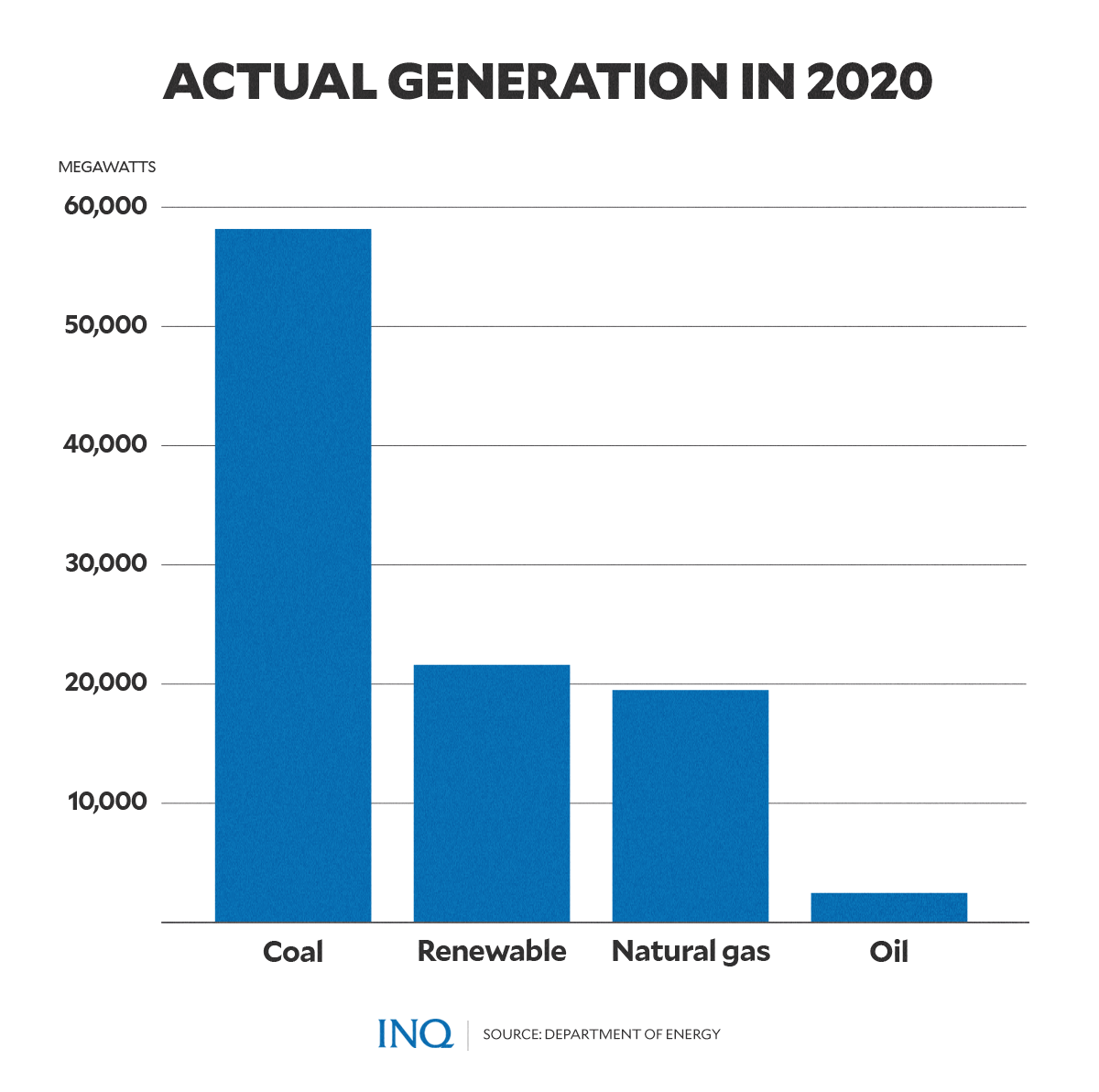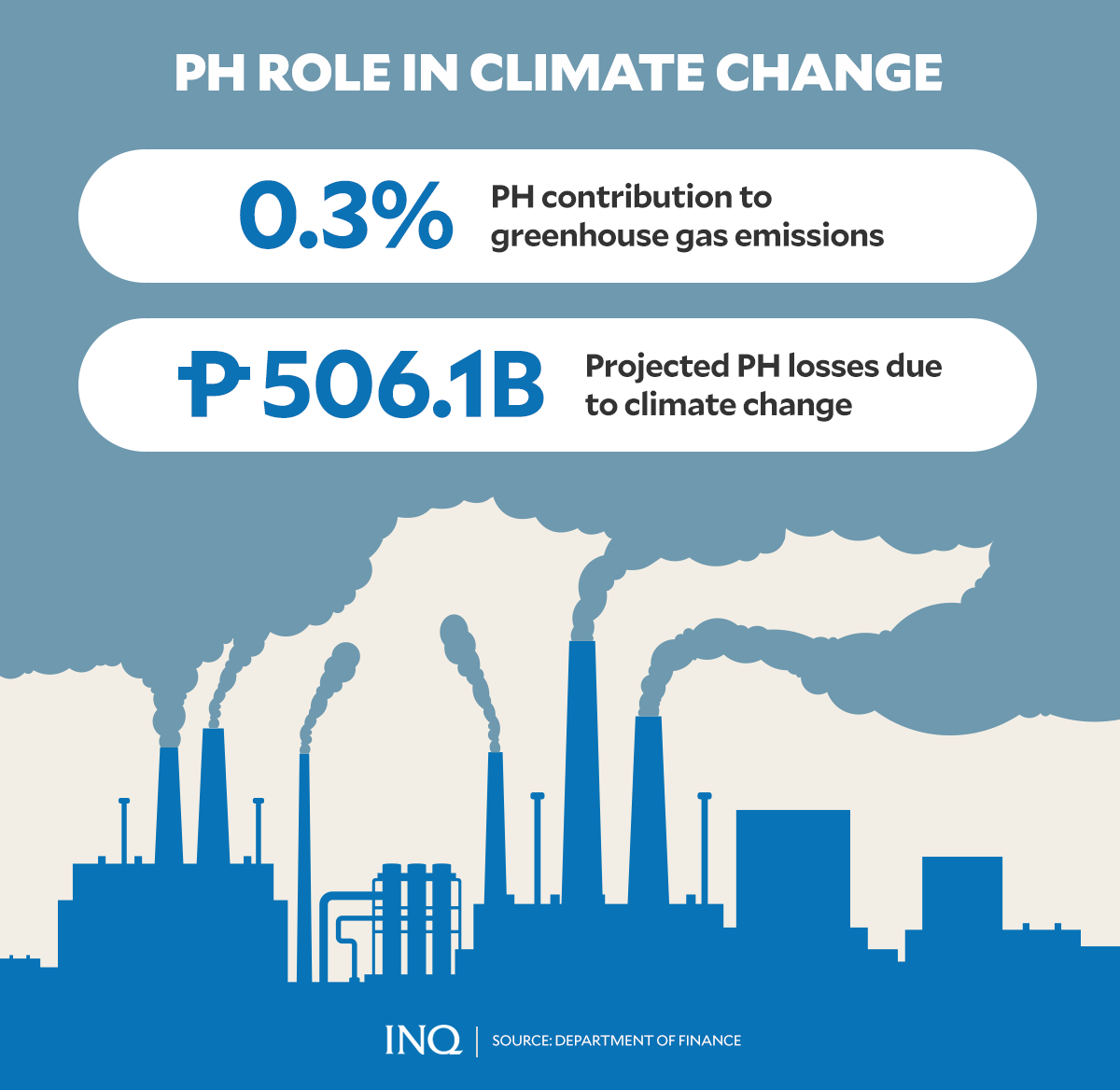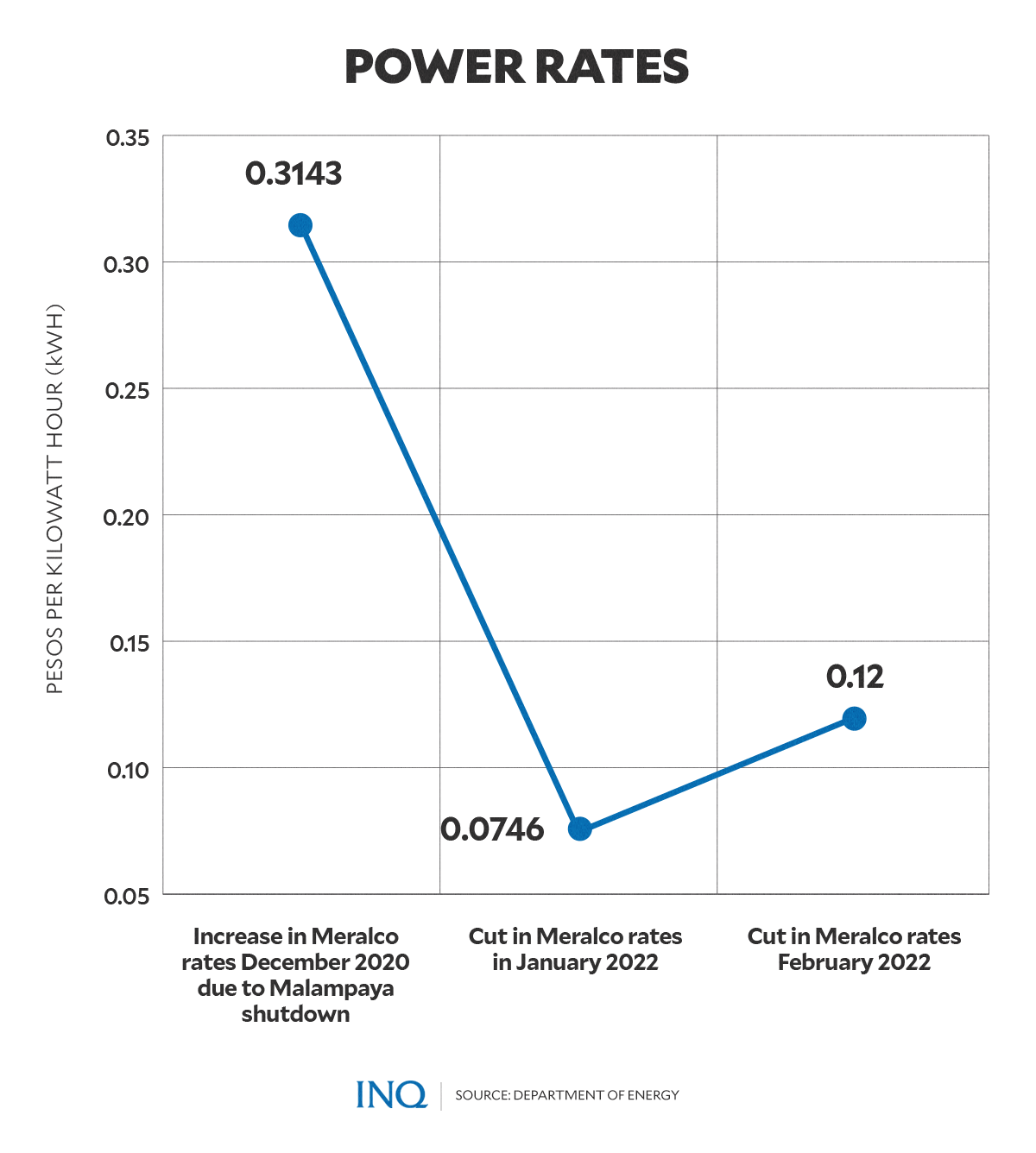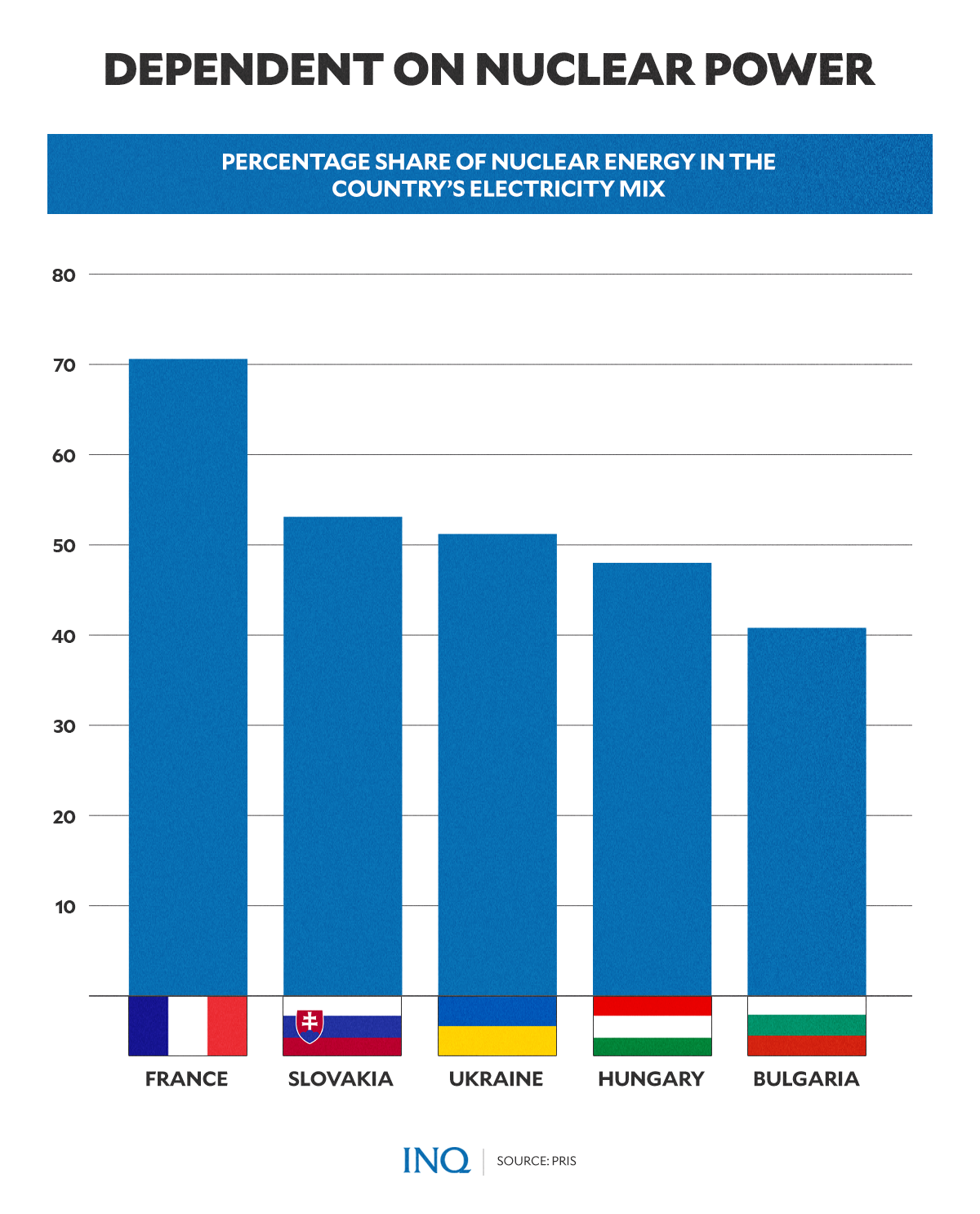Adding nuclear to PH energy mix: Easier said than done
MANILA, Philippines—The Philippines gets its energy from various sources—coal, oil, gas and renewables—so adding another in the mix would not have been controversial. Unless it is nuclear.
In the past few years, the energy mix—or the balance of sources of energy in power supply as defined by Our World in Data—has become an increasingly important subject as many countries began shifting away from fossil fuels as a source of energy.
Countries have begun moving toward low-carbon sources of energy, such as renewables that included hydropower, solar, wind—and most importantly, nuclear.
With the executive order signed by President Rodrigo Duterte last Feb. 28, which encouraged the adoption of a national position for a nuclear energy program, the Philippines might soon join the list of countries that included nuclear in their energy mix.
In this article, INQUIRER.net will explain the executive order and detail some of key information on nuclear energy as described in the EO. This article also aims to answer some of the pressing questions about the possibility of adding nuclear energy to the Philippines’ energy mix.
Quick look at PH’s current energy data
According to data from the 2020 Philippines Power Statistics by the Department of Energy (DOE), the country’s installed capacity in 2020 reached 26,250 megawatts (MW) or 26.25 gigawatts (GW).
Installed capacity, in energy, refers to the maximum output of electricity that a generator can produce under ideal conditions.
The installed capacity per each energy source or technology in the country in 2020 were:
- Coal: 10,944 MW – 41.7 percent
- Oil-based: 4,237 MW – 16.1 percent
- Natural gas: 3,453 MW – 13.2 percent
- Renewable energy: 7,617 MW – 29 percent
Under the total installed capacity for renewable energy were:
- Geothermal: 1,928 MW – 7.3 percent
- Hydro: 3,779 MW – 14.4 percent
- Biomass: 447 MW – 1.7 percent
- Solar: 1,019 MW – 3.9 percent
- Wind: 443 MW – 1.7 percent
The top four energy technologies were coal, oil-based, hydro, and natural gas.
In terms of actual energy generation—the amount of electricity produced over a specific timeline—the big four sources were coal, natural gas, geothermal and hydro.
The country’s total energy generation during the same year was 101,756 MW and the share of each energy source was as follows:
- Coal: 58,176 MW – 57.2 percent
- Oil-based: 2,474 MW – 2.4 percent
- Natural gas: 19,497 MW – 19.2 percent
- Renewable energy: 21,609 MW – 21.2 percent
The energy generation of sources under renewable energy:
- Geothermal: 10,757 MW – 10.6 percent
- Hydro: 7,192 MW – 7.1 percent
- Biomass: 1,261 MW – 1.2 percent
- Solar: 1,373 MW – 1.3 percent
- Wind: 1,026 – 1.0 percent
How does EO 164 change energy mix in PH?
Executive Order (EO) No. 164, which was made public only on March 3, outlined the national government’s position for a nuclear energy program, taking into account economic, political, social and environmental concerns.
“The Nuclear Energy Program is a process that starts with the inclusion of nuclear power in the energy mix based on a pre-feasibility study on the need for and viability of nuclear power,” the EO read.
“It includes the development of nuclear power infrastructure and encompasses the planning and construction, operational, commercial, and post-operational stages of nuclear power plants,” it added.
The order, signed by Duterte three months before the end of his single six-year term, will help prepare the government for the phaseout of coal-fired power plants—similar to other countries.
“The national government commits to the introduction of nuclear power energy into the state’s energy mix for power generation,” the order stated.
READ: Duterte signs EO for nuclear power use as alternative energy source
The order was issued following the recommendation of the Nuclear Energy Program Inter-Agency Committee (NEP-IAC) to adopt the position—based on studies and following the conduct of public consultations and pre-feasibility study.
The EO cited a public perception survey on nuclear energy conducted by the DOE in 2019, which indicated that “almost 79% of Filipinos expressed approval or acceptability of the possible use ore rehabilitation of an existing nuclear power plant.”
“[A]bout 65% approved the building of new nuclear power plants, and more than 78% were willing to learn more about nuclear energy,” the order stated.
READ: Duterte: Include nuclear power in PH energy mix
The Department of Science and Technology (DOST), a member of the NEP-IAC, said in a statement that the EO was the “first step” for the country to use nuclear power.
“The recommendation leading to EO 164 took a whole-of-government approach wherein the multi-agency committee conducted a comprehensive study to achieve a policy encompassing a wide range of issues including the status of the Bataan Nuclear Power Plant (BNPP),” DOST said.
“The recommendation leading to EO 164 took a whole-of-government approach wherein the multi-agency committee conducted a comprehensive study to achieve a policy encompassing a wide range of issues including the status of the Bataan Nuclear Power Plant (BNPP),” it added.
What are the benefits?
EO No. 164 stated that for the country to achieve its sustained growth targets, the national government must ensure a reliable, secure, sustainable, quality, and affordable electricity supply, including sufficient reserve to guarantee that there will be no disruptions.
“Toward this end, and taking into consideration the experience of developed and growing economies, nuclear power shall be tapped as a viable alternative baseload power source along with alternative energy resources, to address the projected decline of coal-fired power plants which come under increasing environmental opposition,” the document read.
“The State envisions nuclear power as a viable component to bridge the gap between rising energy demands and supply, taking into account learnings from the past, national, social and economic development pathways, as well as international legal and regulatory frameworks, and best practices,” it added.
According to the order, the use of nuclear energy could address the increasing demand for clean energy, which is expected to grow by 4.4 percent annually, requiring an additional capacity of 68 gigawatts by 2040.
“Considering this demand and the depletion of natural gas resources, nuclear power will play an important role to contribute to the required capacity to achieve energy security, especially to meet the needs of an emerging upper-middle-income country,” the EO stated.
Moreover, the order noted that nuclear technology could help minimize the possible trade-offs between emissions and the environment.
“Nuclear power can contribute effectively to the mitigation of greenhouse gas (GHG) emissions, and has strong potential to decarbonize the power sector,” it explained.
The Philippines contributed only 0.3 percent to global gas emissions, according to the Department of Finance (DOF), whose chief, Finance Secretary Carlos Dominguez III, headed the Philippine delegation in the 26th Conference of Parties (COP26) in Glasgow last year.
However, the country’s vulnerability to climate change would inflict losses amounting to P506.1 billion, or about $10 billion, in the next 10 years
READ: PH adds only 0.3% to gas emissions but faces P506.1-B losses due to climate change
Last year, the country has committed to the United Nations (UN) its target to reduce GHG emissions by 75 percent between 2020 and 2030.
READ: PH vows to cut gas emissions by 75 percent
Similar to what the EO has stated, Rosatom Overseas—a subsidiary of Rosatom, which according to a Reuters report is a state-run company formed by Russian President Vladimir Putin in 2007 and controls Russia’s uranium production—listed similar benefits of introducing nuclear energy to a country’s energy mix.
Among the benefits of nuclear power, according to Rosatom, were its great energy capacity and reusability. It also backed claims that nuclear power could help reduce GHG emissions and that nuclear power plants could contribute to economic development.
“Active Russian nuclear power plants annually prevent the emission of 210 million tons of carbon dioxide into the atmosphere. In this respect, Russia ranks fourth in the world,” Rosatom Overseas said on its website.
“Construction of nuclear power plants provides economic growth and creates new jobs: 1 job in nuclear power plant construction creates 10–15 jobs in related sectors. The development of nuclear energy contributes to the growth of research and national intellectual potential,” it added.
In 2019, during the Philippine-Russian business forum, a memorandum of intent was signed by Energy Secretary Alfonso Cusi and Evgeny Pakermanov of Rusatom Overseas.
Under that memorandum, the Philippines and Rusatom expressed “intention to jointly explore the prospects of cooperation in the construction of nuclear power plants in the Philippines.”
In a statement released days after, the Department of Energy (DOE) clarified that the Memorandum of Intent was only a “framework for discussion and not for a particular construction of a small modular reactor.”
READ: Putin war on Ukraine: Will it change Duterte’s love for his
Improved PH electric grid performance?
“Nuclear power is envisioned to bring down the cost of electricity and to contribute to energy security considering the various limitations now being encountered in the other sources which include natural gas, geothermal, hydro, coal,” DOST said.
In December, Meralco—the lone power distributor in Metro Manila and its suburbs—collected a P0.3143 per kilowatt-hour (kWh) increase in rates, bringing the average monthly power rate to P9.773 per kWh. The increase in rates, which was reflected in customers’ December bills, was due to the Malampaya shutdown in October.
A typical household consuming 200 kWh per month was charged around P62.86 in electricity bills. Those who consumed 300 kWh, 400 kWh, and 500 kWh paid an additional P94.29, P125.72 and P157.15.
In January and February this year, Meralco announced that it has cut power rates to ₱0.0746 per kWh and P0.12 per kWh.
In terms of energy supply, around May last year, several areas in Luzon were hit by rotating power outages as electricity demand came too close to available supply
According to National Grid Corp. of the Philippines (NGCP), the outages could be the result of a spike in demand while the power reserve is no longer sufficient to meet demand.
READ: Electricity: Supply, demand and more
From April to June last year, the overall rate shot up to P8.4067, P8.59, and P8.6718 per kWh despite the power interruptions experienced by many of Meralco’s customers
“For the country to achieve its sustained growth targets, it must ensure that it has a reliable, secure, sustainable, quality and affordable electricity supply, including sufficient reserve to guarantee that there will be no disruptions in the power supply,” EO 164 read.
Addressing safety concerns
In a statement last week, Greenpeace campaigner Khevin Yu urged Duterte to revoke EO 164, citing safety issues involving nuclear energy and nuclear power plants.
“We believe it is a treacherous move spurred by misguided interests that are not aligned with the interests of the Filipino people. Nuclear is the most dangerous and most expensive source of electricity,” he said.
“The Duterte administration is about to leave a tarred legacy and is setting us up for another horror story like Chernobyl and Fukushima (the two worst nuclear disasters in the world),” Yu added.
READ: Duterte: Include nuclear power in PH energy mix
Previous attempts to pursue nuclear energy in the Philippines failed due to safety concerns, but central to the new plan is the revival of the Bataan Nuclear Power Plant (BNPP), built during the rule of the late dictator Ferdinand Marcos.
The BNPP was the only nuclear power plant in the region during the 1980s as the Philippines was one of the first in Southeast Asia to embark on a nuclear energy program.
However, the project was mothballed because of corruption allegations and safety concerns on the use of nuclear energy after the deadly Chernobyl disaster in April 1986.
A study conducted by Russia State Atomic Energy Corp. in 2017 said the rehabilitation of BNPP would require around $3 billion to $4 billion.
Ferdinand Marcos’ successor, Corazon Aquino, shelved the project indefinitely in 1986, but the country continued to pay for the foreign loans that funded the power plant.
According to Duterte’s EO, the government “shall at all times abide by the international standards on safety, security, and safeguards on peaceful development of nuclear energy.”
“The State is committed to pursue the highest standards of nuclear safety, security, and safeguards, including provision for civil liability, to fulfill its obligations under international treaties and other international conventions and agreements,” the order added.
READ: 7 countries offer to solve Philippines’ power problems
Nuclear power race across the globe
Data from the Power Reactor Information System (PRIS) showed the top 15 countries which produced the most amount of nuclear energy in 2020.
Among these countries were:
- United States: 96 operating reactors, 789,919 GWh nuclear energy supplied, 30.9 percent of the global nuclear power production in 2020
- China: 50 operating reactors, 344,748 GWh nuclear energy supplied, 13.5 percent of the global nuclear power production in 2020
- France: 58 operating reactors, 338,671 GWh nuclear energy supplied, 13.3 percent of the global nuclear power production in 2020
- Russia: 39 operating reactors, 201,821 GWh nuclear energy supplied, 7.9 percent of the global nuclear power production in 2020
- South Korea: 24 operating reactors, 152,583 nuclear energy supplied, 6 percent of the global nuclear power production in 2020
The top five countries that rely most on nuclear energy were:
- France: 70.6 percent share of nuclear energy in the country’s electricity mix
- Slovakia: 53.1 percent share of nuclear energy in the country’s electricity mix
- Ukraine 51.2 percent share of nuclear energy in the country’s electricity mix
- Hungary: 48 percent share of nuclear energy in the country’s electricity mix
- Bulgaria 40.8 percent share of nuclear energy in the country’s electricity mix






